World Economic and Social Survey Archive: 1990-1999
1999
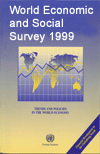 World Economic and Social Survey 1999—Trends and Policies in the World Economy
World Economic and Social Survey 1999—Trends and Policies in the World Economy
Part one: State of the World Economy
Part one of World Economic and Social Survey 1999 provides a chronicle of how large parts of the world economy were sent reeling in the past two years by the fragility of financial systems and their international connectedness. On the whole, the world economy seems to have hit bottom and most of the affected countries are moving towards recovery.
Part two: Financial Development in the Globalizing World
Part two of World Economic and Social Survey 1999 serves as a contribution to the international discussion on "financing for development". It seeks to give a perspective on the major changes that have been taking place in recent decades in the banking and financial systems of developed, developing and transition economies.
1998
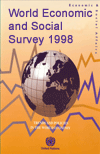 World Economic and Social Survey 1998—Trends and Policies in the World Economy
World Economic and Social Survey 1998—Trends and Policies in the World Economy
World Economic and Social Survey 1998 reviews the turbulence in the world economy over the past year and offers some recommendations on ways and means to address the volatility of global financial flows. It is hoped that this analysis will contribute to the critical debate on confronting the challenges posed by globalization so that the world economy can put present difficulties behind it and resume the more favourable path of earlier years.
1997
 World Economic and Social Survey 1997—Trends and Policies in the World Economy
World Economic and Social Survey 1997—Trends and Policies in the World Economy
World Economic and Social Survey 1997, in addition to providing an overview of current and emerging economic trends, examines the process of fiscal consolidation around the world. Whereas most analyses of this subject have been undertaken from a purely economic point of view, the Survey seeks to underline the role of political considerations in successful fiscal reforms.
1996
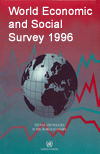 World Economic and Social Survey 1996—Trends and Policies in the World Economy
World Economic and Social Survey 1996—Trends and Policies in the World Economy
World Economic and Social Survey 1996 sees increasing grounds for optimism in the global economy, although considerable problems remain. The Survey was issued shortly after the success of the United Nations Conference on Human Settlements (Habitat II) and agreement on the need for a new global urban agenda. In addition to reviewing data and projections on the extent of urbanization, it examines trends in the provision of electric power in developing countries and alternative institutional arrangements for meeting the world's growing demand for water. Both questions are central to the implementation of the Global Plan of Action adopted in Istanbul.
1995
 World Economic and Social Survey 1995—Current Trends and Policies in the World Economy
World Economic and Social Survey 1995—Current Trends and Policies in the World Economy
World Economic and Social Survey 1995 points to two economic and social realities existing side by side. At a time when the global economy is comparatively healthy, many regions are enjoying increasing prosperity and show an ability to sustain their growth. Simultaneously, for many of the world's citizens, this is an era of hardship—and worse suffering seems to lie ahead. In a world that is tightly linked economically, this imbalance threatens the long-term welfare of both developed and developing economies.
1994
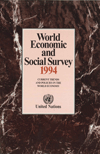 World Economic and Social Survey 1994—Current Trends and Policies in the World Economy
World Economic and Social Survey 1994—Current Trends and Policies in the World Economy
World Economic and Social Survey 1994 is being released for the first time under this title, signalling the intention to integrate more fully the treatment of the economic and social dimensions of development. In addition to the usual overview of current and emerging economic trends, the 1994 Survey focuses on the issue of unemployment, which has become one of the major economic and social challenges faced primarily by developed market economies but also by countries on a global level. It also addresses demographic changes and their social, economic and environmental consequences.
1993
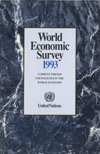 World Economic Survey 1993—Current Trends and Policies in the World Economy
World Economic Survey 1993—Current Trends and Policies in the World Economy
World Economic Survey 1993 highlights the persistent weakness in the developed market economies and a further steep fall in output and living standards in the economies in transition as the dominant features of the world economy in 1992. Despite strong growth in a number of developing countries, accounting for half of the world's population, there was negligible growth in the world economy overall. In 1993, for the third year in a row, the growth of world output will fall below world population growth.
1992
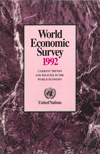 World Economic Survey 1992—Current Trends and Policies in the World Economy
World Economic Survey 1992—Current Trends and Policies in the World Economy
World Economic Survey 1992 examines the effects of the historically and politically important events that took place in the world economy in 1991. Beyond these, the global economic landscape was marked by inaction and disappointments. The developed market economies slumped, but caution prevailed and no decisive steps were taken to stimulate growth. The developing countries maintained the modest rate of economic growth seen in recent years.
1991
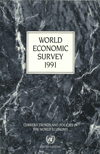 World Economic Survey 1991—Current Trends and Policies in the World Economy
World Economic Survey 1991—Current Trends and Policies in the World Economy
World Economic Survey 1991 examines the historical, political and economic developments that made 1990 an extraordinary year of shocks and contrasts for the world economy. These developments resulted in the slowest rate of growth of world output since 1982. Per capita income declined in large parts of the world. The forecast for 1991 is zero growth overall, with large-scale declines in the output of Eastern Europe and the Soviet Union and recession already visible in the developed market economies.
1990
 World Economic Survey 1990—Current Trends and Policies in the World Economy
World Economic Survey 1990—Current Trends and Policies in the World Economy
World Economic Survey 1990 analyses the effects of the great political and economic changes in 1989. It provides an overview of the major issues, a review of the changes that have taken place in the international economy in the 1980s, and an agenda for national and international action. The Survey also contains an assessment of the causes and consequences of desertification in developing countries. A special section is dedicated to the socio-economic attainment of women in recent years.

Follow Us